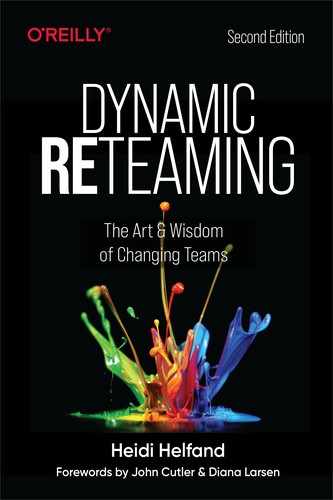Foreword by Diana Larsen
Heidi Helfand notices. That’s one of the first things I learned about her as we became better acquainted. I’ve enjoyed getting to know Heidi. I’ve also received side benefits of her ability to notice what’s going on and to discern the response needed.
Heidi notices what’s going on in a situation and then dives deeply into making sense of it. She discerns patterns in personal, group, and organizational dynamics. But she doesn’t stop there. She recognizes how she can contribute to our learning about those patterns. Heidi helps us see what she sees.
This book, Dynamic Reteaming, demonstrates this attribute of noticing. Heidi noticed that the conventional wisdom about teams didn’t match reality. She became curious. Heidi is also bravely willing to challenge conventional wisdom. In this way, she adds “role model for leaders” to her role as author.
She understood a generalization that many of us take for granted—team members work better together as they interact over time. She also recognized the flaw in its corollary—strive to keep team membership stable. Heidi saw it differently. While this is an interesting ideal, it’s not the lived reality in most organizations. People and organizations are not tidy, and unexpected stuff happens.
Team members (a.k.a. people who have lives) leave teams for a variety of reasons. New people join growing teams. Products undergo changes based on customer needs and shifting business directions. New products emerge. New versions need team members with institutional and system memory to work on them. Where do those folks come from? Prior team assignments.
Once she noticed these realities, Heidi didn’t just shrug her shoulders and say, “Oh well, too bad, that’s just the messy way things are.” Nope. She researched the many reasons that team membership can shift. Then she codified them and offered them to her readers. She wants to help us see the situation and work through it well. Heidi categorized more than a dozen drivers for reteaming and five patterns in ways team membership shifts. Her work enables us to think more clearly and deeply as we anticipate change in the makeup of our teams.
So Heidi shares good reasons for reteaming. Including the word dynamic in the title tells us that we must understand and apply good practices for implementing it. In some instances, many new teams are needed all at once. At other times a single team loses or gains a new member. Heidi gives us guidance on why and suggests how to reteam as a conscious process. She adds examples of effective ways to help newly formed teams accelerate into shared performance.
I particularly appreciated the reports about teams forming, adjourning, and reforming. Heidi has collected experiences from our colleagues all around the world. Heidi’s many current and former coworkers offered their accounts. Generous practitioners from around the world shared theirs as well. I enjoyed reading stories from Rachel Davies, Christopher Lucian, Sandy Mamoli, Elaine Bulloch, Cristian Fuentes, Kristian Lindwall, Evan Willey, Jason Kerney, and many more. These stories add rich narrative. They give us insight into the many reasons for reteaming and the many forms it takes. The examples recognize the many ways that reteaming can be effective and fit for different purposes and functions.
Heidi has grown her own practice and skill at leading production and business outcomes through teams. Along her path, she has accumulated a formidable list of resources. Throughout the book I found familiar references to most books or articles relating to teams that I have in my own library. I also found many more that are now on my “order this one next” list.
Finally, I appreciate the way Heidi’s Dynamic Reteaming work extends my professional interests. We share this devotion to fostering healthy, productive teams. This book includes applications for retrospectives, team liftoffs and chartering, and teams’ shared learning and skills building. I also recognized examples that describe teams seeking fluency in all the zones of the Agile Fluency™ Model, as well.
If you have software development teams in your organization, you owe it to yourself to read this book. Whether you know it or not, your next “reteaming” is just around the corner. Be prepared.
